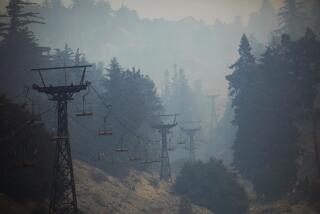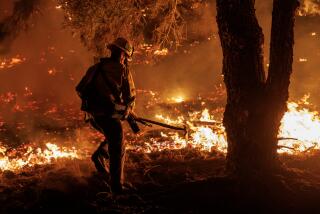In certain surveys on ski resorts, it’s not easy being green
If you think it’s easy finding out whether your favorite ski resort is a good environmental citizen, you probably also think navigating moguls on one ski is a cakewalk.
It’s not that there are no data. The ski industry and activists have spun mountains of reports on the topic. But they agree on very little.
For the record:
12:00 a.m. Feb. 5, 2003 For The Record
Los Angeles Times Wednesday February 05, 2003 Home Edition Main News Part A Page 2 National Desk 15 inches; 548 words Type of Material: Correction
Audubon -- The Travel Insider column in the Jan. 19 Travel section said that a golf course at Northstar-at-Tahoe was dubbed a “cooperative sanctuary” by Audubon International. That group is not affiliated with the National Audubon Society.
For The Record
Los Angeles Times Sunday February 09, 2003 Home Edition Travel Part L Page 3 Features Desk 5 inches; 180 words Type of Material: Correction
Audubon -- The Travel Insider column in the Jan. 19 Travel section (“In Certain Surveys on Ski Resorts, It’s Not Easy Being Green”) said that a golf course at Northstar-at-Tahoe was dubbed a “cooperative sanctuary” by Audubon International. That group is not affiliated with the National Audubon Society.
Take Northstar-at-Tahoe. “The environment is our livelihood, and we will treat it with respect,” the Lake Tahoe resort says on its Web site, www.skinorthstar.com. Its waste management efforts have won awards for six years from a state recycling agency, its golf course was dubbed a “cooperative sanctuary” by Audubon International and it is test-driving low-polluting biodiesel fuel in its buses this season.
Yet Northstar got an F on an annual environmental scorecard of 70 Western resorts issued in November by the Ski Area Citizens’ Coalition, an alliance of five private, nonprofit activist groups. The grades are based on public records and self-reports from the resorts, about half of which responded to the most recent survey, said coalition chairman Jeff Berman.
Northstar flunked partly because it opened 200 more acres of ski runs two years ago and because it plans to expand its village and build more housing, according to the coalition’s report at www.skiareacitizens.com.
Northstar was not the only resort that failed, but it was the only one in the California-Nevada region, which overall got a B, the highest average grade among five Western regions. (The region of Idaho, Montana and Wyoming got a D, the lowest grade.) Among the A’s were four California resorts: Alpine Meadows, Sierra Summit, Snow Summit Mountain Resort and Snow Valley Mountain Resort.
Northstar spokesman Toby Baird defends his resort’s record, calls the F unfair and says the grading system is weighted against any development, even the kind that reduces vehicular traffic, such as close-in housing for employees and skiers.
Stronger words come from Geraldine Link, director of public policy for the National Ski Areas Assn., which represents 332 U.S. resorts and sponsors an annual “Sustainable Slopes” education day at the resorts (Feb. 22 this year) that publicizes its environmental programs.
She calls the Ski Area Citizens’ Coalition survey a “publicity stunt” and alleges it is biased, awarding A’s to resorts that answer the survey and flunking some that are in litigation with coalition members.
Berman denies these allegations. He says members are in litigation with some of the resorts but that “we use an even brush” in grading. He also says the industry association discourages resorts from answering the survey.
Link responds: “We don’t tell our members what to do,” although she does “educate members as to [the survey’s] bias.”
The ski association’s “Sustainable Slopes” program is “mostly an attempt to greenwash the environmental impacts ... that ski resorts can and do often have,” mainly by expanding into the national forest areas where many of them are, Berman says. “In no way does recycling, for instance, mitigate the effects of destroying old-growth forest.”
Since 1999, when it adopted an “Environmental Charter,” the National Ski Areas Assn. has pursued an extensive, albeit voluntary, environmental program. For three years it has conducted an annual survey of members’ efforts in this area. The latest “Sustainable Slopes Annual Report,” issued in June 2002, can be downloaded from its Web site, www.nsaa.org. The Web site also has detailed reports on each resort’s programs. (Click on “The Greenroom” and select the resort from a pull-down menu.)
The annual report makes an interesting counterpoint to the Ski Area Citizens’ Coalition scorecard. The latter focuses on resort expansion, but the former focuses on recycling, energy saving and similar issues.
Resorts are buying wind power from utilities, upgrading snow-making equipment so it consumes less energy, building energy-efficient structures and running free shuttle buses, among other initiatives, Link says. She gives the industry an A for its efforts in the last couple of years.
As for new development, Link says, the resorts are simply giving customers what they want.
“Snowboarders and skiers are environmentally conscious,” she says. “But when it comes to choosing a ski resort, they want the things that give resorts a bad grade in [the coalition’s] report” -- including fresh terrain, snow-making and ski-in, ski-out lodging on the mountain.
Resorts’ expansion and development plans -- the heart of environmentalists’ objections -- have lately made news. They include the nearly billion-dollar remake of Mammoth Mountain and Telluride’s 733-acre Prospect Bowl addition in 2001.
Quantifying the extent to which -- or even whether -- ski resorts overall are expanding nationwide is difficult. Neither the U.S. Forest Service nor the National Ski Areas Assn. says it has historic data.
There are some figures for individual forests. Colorado Ski Country USA, which represents Colorado resorts, says skiable acres in the White River National Forest more than doubled, from 9,838 to 19,616 acres, between the 1985-86 and 2002-03 seasons.
The White River is home to 12 ski resorts, including Aspen, Beaver Creek, Breckenridge and Vail.
As for the future, forest service officials say their current plan for White River, which directs land use for the next 15 years, actually decreases the area allocated for downhill skiing and snowboarding to 51,500 acres from the 93,000 acres in its 1984 plan. In either case, the skiing acreage is a minuscule percentage of the forest’s 2.3 million acres, they say.
In explaining the decrease, they say several planned resorts never got built and that some wetlands and habitats of endangered species were marked off-limits. (Only about 45% of the land allocated -- in effect, zoned -- for skiing is typically used, they say.)
The current plan has been hotly contested by resorts and anti-growth forces. More than a dozen appeals are pending.
The crossfire is typical of so much in the debate over skiing and the environment.
Come to think of it, navigating moguls with no skis would be easier.
*
Jane Engle welcomes comments and suggestions but cannot respond individually to letters and calls. Write Travel Insider, Los Angeles Times, 202 W. 1st St., Los Angeles, CA 90012, or e-mail jane.engle@latimes.com.
More to Read
Sign up for The Wild
We’ll help you find the best places to hike, bike and run, as well as the perfect silent spots for meditation and yoga.
You may occasionally receive promotional content from the Los Angeles Times.






